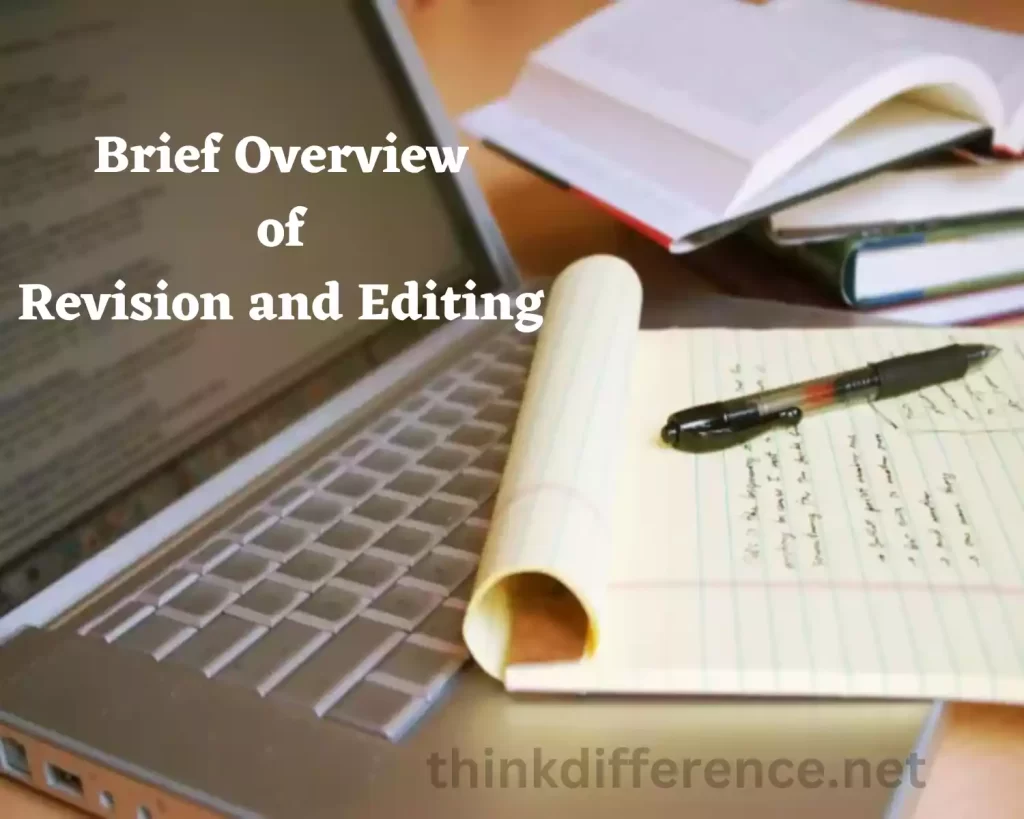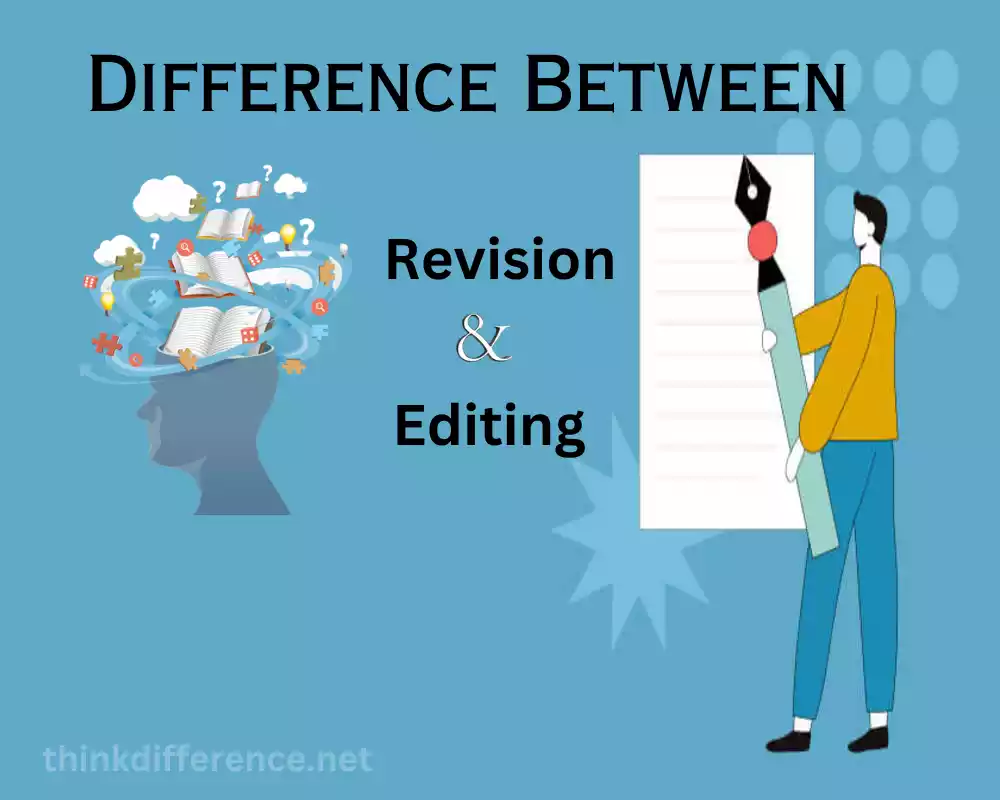Brief Overview of Revision and Editing
Revision and editing are key steps of the writing process, yet each serves different functions, focusing on particular elements that require attention.
Revision is the practice of making major modifications to any written piece, including its structure, content, and organization. The revision aims at increasing clarity, consistency, and effectiveness with which messages are conveyed; writers may rearrange, delete or add sections during revision to ensure better flow and impact; in addition, this holistic process takes into consideration aspects like the logical flow of ideas, arguments strength, and overall structure in their analysis improving communication by reaching its intended target audience more successfully.

Editing is more technical and precise. It involves correcting grammar, punctuation, and spelling errors as well as style to enhance the readability and professionalism of texts. Editing involves checking texts for errors such as formatting issues as well as improving word choice clarity and consistency – this step usually follows revision and serves to enhance the final product.
Revision involves reviewing, altering, and refining both structure and content within written pieces; while editing focuses more closely on their mechanics and specificities. Both steps of writing – revision and editing – are integral parts of producing quality writing; therefore they should be treated separately from one another during this stage in the writing process.
Importance of revising and editing in the writing process
Revising and editing are integral to producing high-quality writing work. Here are a few reasons why revising and editing are necessary:
- Clarity Enhancement: Revision and editing allow writers to refine their thoughts, increase clarity and enhance readability. By revising, authors can strengthen their message while making sure ideas are organized logically while eliminating unclear or confusing sections; editing helps eliminate grammatical mistakes, awkward phrases, or any potential barriers which impede comprehension.
- Revision to Enhance Organization and Coherence: Revision allows writers to assess the organization and structure in their writing. By rearranging sections or paragraphs, repositioning thoughts, improving transitions, or rearranging sentences/paragraphs to ensure smooth flow; editing improves engagement while adding logic for improved structures.
- Strengthening Arguments & Presenting Evidence: Writers can assess their argument’s strength and relevance during revision by discovering any gaps in reasoning, providing necessary details, or eliminating unnecessary details. By revisiting and revising previous work they have completed, writers can strengthen and make their main points more persuasive while strengthening any weak spots they might find in existing writing projects.
- Polishing the Writing Style: Editing allows writers to refine their style of writing and language usage, including checking the consistency of tone, vocabulary, and sentence structure. Writers should replace weak words or phrases with precise alternatives while eliminating unnecessary jargon and cliches from use and maintaining professional tones when possible.
- Correction of Errors: Revision and editing are crucial steps for spotting errors in grammar, punctuation, and spelling that might damage credibility and professionalism in writing. By editing carefully writers can fix typos or grammar issues while adhering to standard language conventions.
- Enhancing Readability: Revision and editing can greatly increase the readability of written work. Clarity, style, and organization can all be refined for an engaging reading experience for an audience. A well-edited piece will capture their attention while still effectively conveying its intended message.
Revision and editing are integral steps of writing. By dedicating enough time for revision and editing, writers can refine their ideas, clarify messages, improve the structure, fix errors, and enhance the quality of their writing work. With careful revision and editing efforts writers can craft effective, impactful writing that stands the test of time.
What is Revision?
Revision refers to the process of reviewing, reassessing, and making significant alterations to a written work. Revision involves restructuring its contents, structure, and organization for improving overall quality and effectiveness.
Revision allows writers to step back and analyze their work critically from an objective viewpoint, checking for clarity, coherence, and logical flow between ideas. Revision helps writers refine their message while strengthening arguments so their intended meaning reaches readers effectively.

Key aspects of revision include:
- Content Evaluation: Writers carefully assess their content’s relevance and substance. They assess if ideas have been fully developed, supported by evidence, and aligned with their purpose. Revision often means adding new data or sections or revising previous ones to make their piece more impactful.
- Structure and Organization: Writers regularly assess and assess their writing structure and organization. They analyze how paragraphs flow, ideas progress logically, and how effectively between sections interact. Revision may involve moving paragraphs around, adding subheadings, or revising your structure for greater clarity and coherence.
- Clarity and Coherence: Writers must prioritize clarity and coherence when crafting their works of fiction or non-fiction writing, making sure their ideas can be readily comprehended by readers. Revision includes clearing away confusing sentences or phrases; improving language usage; eliminating unnecessary jargon; as well as using transition words or connective phrases for better flow.
- Audience Perspective: Writers take care to consider their intended audiences when creating writing. They assess if their writing successfully conveys its intended message while being engaging and accessible for readers in target demographics. Revision processes may involve tailoring style, tone, or technical aspects of text to meet audience expectations.
- Improvement: Revision seeks to enhance the quality of writing. The revision process enables writers to critically appraise their works, identify areas for improvement and make significant modifications that create stronger pieces that shine with polish. Revision processes may involve multiple iterative rounds for review and refinement of texts.
Revision is an integral component of writing. Re-evaluating and refining one’s work allows writers to strengthen its clarity, content, and structure for maximum reader benefit – thus helping their message resonate effectively with its intended target.
What is Editing?
Editing is the review and improvement of written works through focused scrutiny of its finer details, such as fixing errors and polishing language according to certain standards and guidelines. Editing usually follows revision as an extra step intended to boost writing with increased precision, clarity, and professionalism.

Key aspects of editing include:
- Grammar, Spelling, and Punctuation: Grammar, Spelling, and Punctuation: Editors carefully inspect a text to spot and correct any inconsistencies with grammar, punctuation, or syntax errors. By checking to ensure sentences are correctly constructed with words spelling properly spelled appropriately punctuation used appropriately as well as maintaining its readability this step keeps writing consistent throughout its entirety.
- Language and Style: An editor’s primary task is to improve sentence structure, cut wordiness and redundancies out, ensure consistent tonality/voice throughout, suggest alternative word choices or even rephrase sentences as necessary to increase clarity/conciseness and create better clarity/concision of message.
- Consistency and Formatting: Editors ensure consistent formatting such as font sizes, heading styles, and indentation for writing that follows specific style guidelines such as MLA or APA. Consistent formatting enhances the visual appeal and professionalism of documents.
- Fact-Checking and Accuracy: Editors use fact-checking services to assess the accuracy of data, facts, references, and references within written works. They cross-check sources to make sure information remains current; as it’s essential when writing nonfiction or academic materials that all information be accurate.
- Clarity and Readability: Editors evaluate both clarity and readability, looking out for areas that might confuse their readership, before offering suggestions to enhance understanding, such as rephrasing complex phrases, changing sentence structures, or including additional clarification information.
- Proofreading: Proofreading is an integral component of editing, which involves reviewing a final text version to spot any inaccuracies, inconsistencies, or typos that might otherwise go undetected; such as typographical mistakes, missing words, or format issues as well as any minor discrepancies which might otherwise go overlooked.
Editing is a practice designed to enhance accuracy, consistency, and clarity in writing. The aim is to polish text for final publication while editors bring their attention to detail and language skills in improving written work quality.
Differences Between Revision and Editing
Revision and editing are integral steps of the writing process, their goals, techniques, and focus can differ considerably.
Here are a few differences between editing and revision:
1. Focus:
- Revision: Revision is an essential process that addresses both structure and content in written works. Revision involves revisiting, restructuring, and refining various aspects such as message clarity, coherence, and effectiveness – the main objectives being clarity, coherence, and effectiveness.
- Editing: Editing involves fine-tuning technical aspects like grammar and punctuation to enhance the readability and professional appearance of a text. This may involve fine-tuning language usage to maintain consistent usage as well as eliminating mistakes to achieve optimal readability and professionalism in its final version.
2. Goals:
- Revision: Revision is used to strengthen writing quality through refining content, strengthening arguments, and optimizing structure. The goal is to produce a unified piece that effectively conveys its intended message to the intended target audience.
- Editing: Editing serves the purpose of perfecting the final draft by correcting errors, improving language style, and meeting specific guidelines or requirements. Ultimately, editing ensures consistency, accuracy, and clarity within text content.
3. Techniques:
- Revision: Revision is the act of making significant modifications in terms of content and structure to an original work, including rearrangement of sections or their elimination altogether, modifications in arguments, or rearrangement in terms of ideas; revision includes critical review as a whole as well as multiple rounds of refinement until you achieve optimal results.
- Editing: Editing involves honing in on the subtle details and technical components that may otherwise go undetected during proofreading and revision phases. Proofreading entails searching for errors such as grammar and spelling mistakes as well as improving sentence structure, word choice, and formatting issues; whilst editing requires greater precision. Typically following revision, edits usually focus more closely on these finer points before proceeding further with further edits or revising phases.
4. Timing:
- Revision: Revision is typically undertaken during the middle to early stages of writing. Once a first draft has been finished, revision provides writers a chance to take a step back and look at their work objectively before potentially going through multiple revisions as they refine and shape it further.
- Editing: Editing occurs once a writer has finished revising and is satisfied with both content and structure of his or her writing, before sharing it with readers or an intended audience. Specifically, editing involves reviewing every fine detail to ensure accuracy and consistency within his final draft.
Revision and editing are distinct stages within the writing process that each has specific goals and aims. Revision involves making significant modifications to content and structure to increase effectiveness and quality, while editing focuses more on improving technical aspects, correcting mistakes, and increasing readability and professionalism – two essential processes when producing high-quality written works.
Similarities Between Editing and Revising
Editing and revising share numerous similarities despite having different goals and purposes. Here are a few commonalities between revising and editing:
- Iterative Process: Editing and revision are iterative processes that involve multiple rounds of review. At each stage, reviewing, revising, and reassessing should take place frequently to continuously enhance and perfect one’s work.
- Improvement of the Writing: Editing and revising are both methods used to strengthen writing. Both have distinct goals; editing may focus on content or structure while revising may concentrate more on technical details both strive for the goal of improving, clarifying, and expanding written works in terms of clarity, impact, and enhancement.
- Attention to Language and Expression: Both stages require paying close attention to both language used and expression in your writing. Revision seeks to assess clarity and coherence within their ideas to ensure they come across clearly, while editing focuses on strengthening sentence structures by eliminating errors to increase readability and professionalism.
- Consideration of the Audience: Editing and revision are processes designed to meet the audience’s needs and expectations. Writers assess whether their writing successfully conveys its intended message to an audience before making modifications accordingly. When editing texts for target readers, language, style, and formatting should all be checked to ensure an accessible reading experience for target readers.
- Collaboration and Feedback: Both stages benefit from collaboration and feedback, whether that means asking other writers, peers, or professionals for input; receiving feedback helps identify areas for improvement as well as guide revision and editing processes.
- Enhancement of Quality: Editing and revising both play an instrumental part in strengthening writing quality. They enable writers to refine ideas, strengthen arguments, improve organization, eliminate errors, and enhance readability – key ingredients of crafting quality writing pieces that shine with excellence! Editing and revision can transform text from mere drafts into polished masterpieces!
Revision and editing share similar goals of improving quality, clarity, and impact in writing pieces. Both stages necessitate an evaluation of writing as a whole as well as constant improvements and should both work hand-in-hand to produce high-quality written pieces with lasting effects. By harnessing both strengths, writers can produce superior and more impactful written works.
Best Practices for Revision and Editing
Here are a few key takeaways when editing and revising writing:
- Take a Break: When beginning the revision process, give yourself some space before diving right in. Take some time away – from hours or even days – from writing before jumping back in with both feet. This can give your writing a fresh new perspective!
- Create a Revision Process Plan: Create a revision process plan which details your approach to revising. Pay particular attention to specific aspects or areas of writing like organization, clarity, or strengthening arguments; using such an outline will keep you on track while making sure all necessary elements of revision are covered during editing.
- Request Feedback: Seek feedback from peers, writing groups, or instructors as an invaluable way of improving your writing and uncovering blind spots within it. Use constructive criticism as guidance during revision.
- Start at the Beginning: Analyse Your Writing Structure, Content, and Coherence to Assess how ideas are being presented; their flow logically through arguments; the effectiveness of the organization as well as whether changes must be implemented to both enhance message delivery as well as strengthen it further
- Verify Clarity and Consistency: Check that your writing is straightforward, clear, and easily understood by paying close attention to sentence structure, word selection, and any unnecessary jargon that may exist within. Aiming for simplicity and clarity within writing may increase reader comprehension significantly.
- Review Sentence Flow: Take note of how sentences flow and transition between paragraphs. Utilize transitional phrases or words that link ideas logically; this will improve the coherence of your writing overall.
- Carefully Proofread: In the editing phase, proofreading should focus on finding any typographical, grammar, punctuation, and/or spelling errors in your work. Careful reading or even aloud may help pinpoint problems; use grammar/spell-check tools judiciously but don’t rely exclusively on them as tools of proofreading.
- Maintain Consistency: For an increase in professionalism and coherence of your work, ensure there is consistency across the language, format, and style of your document. Make sure to adhere to style guides such as APA or MLA when following these specific style guides/guidelines. Consistency will enhance both professionalism and cohesion of the finished piece of writing.
- Edit in Multiple Passes: For optimal editing results, do not try to cover every element in one pass of editing and revision at once. Divide revisions and edits into separate rounds that focus on different aspects; that way you can target specific areas to make targeted and thorough improvements.
- Proofread Again: Always perform one last check of your project to ensure there are no mistakes or inconsistencies before finalizing or publishing it, paying special attention to punctuation and capitalization issues as needed. Review to confirm your document is error-free before submission or publishing.
Revision and editing processes depend upon personal preferences and writing goals; adapt these tips according to what works for your writing style and needs.
What Comes First, Revision or Editing?
Revision is often the precursor to editing in the writing process. Revision involves reviewing your writing and making significant modifications to its structure and organization – with an aim towards increasing clarity, effectiveness, and impact of what has been written. Revision should focus on refining ideas, strengthening arguments, and strengthening effectiveness compared with editing alone.
Revamp allows writers to step back, assess their writing critically, and make significant alterations to it. Revision may involve rearrangement, addition or subtraction of sections, new content creation or removal, or changes in structure of documents – this stage provides writers the chance to address major problems or weaknesses with their work and make sure their message has been successfully communicated.
Editing begins once revision has been completed and approved by the writer, and after they have reviewed its structure and content. Editing involves finer points like grammar and punctuation to improve writing while correcting errors, increasing language ability, and adhering to specific guidelines or standards.
Revision and editing enable writers to address larger issues like content and structure before delving deeper into details like language usage and style. This approach ensures an efficient way of increasing both quality and effectiveness in written works.
Epilogue
Revision and Editing are essential elements of the writing process that elevate your content to new heights. Embrace these stages with enthusiasm, and you will witness your work transforming into a polished and powerful piece of art. So, the next time you find yourself immersed in the creative process, remember that the true magic lies not in the first draft, but in the art of revision and editing.



